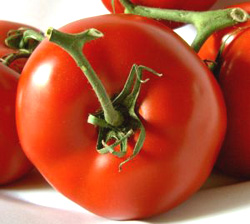

Too often seen as just a Bloody Mary mixer, a great tomato juice is its own reward. A lesser tomato juice can hide in a Bloody Mary with distractions like Worcestershire sauce, horseradish, lemon juice, garniture and the vodka. The rim of this beauty is dipped in Morton’s Hot Salt, which is seasoned with chipotle pepper. Photo courtesy of Morton Salt.
|
KAREN HOCHMAN is editorial director of THE NIBBLE.
BETH COLLINS is a contributing editor.
|
|
April 2006
Last Updated May 2013
|
 |
You Say “Tomato” [Juice]
Page 3: A History Of Tomatoes & Tomato Nutrition
This is Page 3 of a three-page article. Click on the black links below to visit other pages.
History of the Tomato
The tomato is a native of Mesoamerica: it was cultivated by the Aztecs and Incas. In 1519, Cortez found it growing in Montezuma’s gardens, and it became part of the culinary bounty brought back to Spain (along with chocolate and turkeys) by the 16th-century conquistadors. Most of Europe embraced them, except the British, who believed them to be poisonous (a member of the deadly nightshade family, the leaves are poisonous if consumed in large quantity).
French botanist Tournefort bestowed the Latin botanical name Lycopersicon esculentum, which translates to “wolf-peach,” a reference to the third century writings of Galen concerning a poison in a palatable package which was used to destroy wolves. The English word tomato comes from the word brought back from the New World by the Spanish, the Aztec/Nahuatl word tomatl, pronounced toe-MAH-tay, which became the Spanish word tomate. Native versions were small, like cherry tomatoes, and most likely yellow rather than red. In Spain and Italy, they were known as pomi d’oro, golden apples. And, as members of the Nightshade family which includes poisonous plants, they were deemed inedible and used only as decorative plants for 200 years, until famine in Italy caused starving peasants to eat them.
After five centuries of breeding, there are thousands of varieties of tomatoes in a vast array of shapes, colors and sizes. The most common shapes in the U.S. are round (beefsteak and globe), pear-shaped (roma and plum) and the miniature (cherry and grape).
The Tomato: Fruit or Vegetable?
Is the tomato a fruit or a vegetable? It is the fruit of the tomato plant. Scientifically speaking, it is a fruit: It is developed from the dry ripened ovary in the base of a flower, and contains the seed(s) of the plant (though cultivated tomatoes may be seedless). It can be further classified as a berry since it is pulpy and has edible seeds. Apples, oranges, pears, blueberries, raspberries and oranges are true fruits.† Many kinds of nuts are also true fruits, as are the avocado, tomato and—more surprisingly—the bean pod, bell pepper, hot chile pepper and zucchini.
†Some plants have a soft part which supports the seeds and is also called a fruit, though it is not developed from the ovary: the strawberry, which has its seeds on the outside, is an example.
Science notwithstanding, on May 10, 1893, tomatoes were declared a vegetable by the United States Supreme Court. At the time, there were import tariffs on vegetables but not fruits, yet tomatoes were still being subjected to the tax. In 1887, an importing company had sued the tax collector of the port of New York to recover back duties collected on their tomatoes, which they claimed had been wrongfully classified as vegetables. The Court decided that the tariff act should be based “in common language of people,” not botanists, so tomatoes should be taxed like potatoes, carrots, parsnips, turnips, beets et al. You can read the case summary here.
A good rule of thumb to determine if something is a fruit is not whether it is sweet, but if it has seeds. That means that acorns, almonds, cucumbers, green beans, squash, walnuts and zucchini are fruits; and the asparagus, broccoli, carrot, celery, lettuce, onion and potato are vegetables. Non-botanists—cooks and those of us who eat their cooking—call some produce that are scientifically fruit, “vegetables,” because they are savory rather than sweet. By the same token, the term “fruit” is used to refer to vegetables which are not fruits, but are used in sweet cooking—rhubarb, for example.
|
|

The fruit of the tomato plant. If you want to be accurate, never call it a vegetable. Photo by Rick Hawkins. |
In all of its forms (tomato sauce and juice, e.g., as well as raw), the tomato is the second most widely consumed vegetable in the U.S., after the potato.
And you thought you were just going to learn about a better tomato juice!
Health & Nutrition
Far from being poisonous, tomatoes contain the antioxidant lycopene, which studies continue to show seems to have an ability to reduce the risk of prostate cancer. Tomatoes also contain the antioxidants vitamin C and carotenoids (including beta carotene), which are believed to provide protection from free radicals that cause premature aging, cancer, heart disease and cataracts.
Tomatoes are low in calories, about 35 for a medium tomato, but proportionately high in sugar—a corresponding 8 grams. Its juice is naturally low in sodium (one cup has 1% of your daily value) and zero fat. It is also a good source of copper, iron, magnesium, manganese, niacin, pantothenic acid, thiamin and vitamin K; and a very good source of folate, potassium, and vitamins A, B6 and C.
Go To The Article Index Above

|





